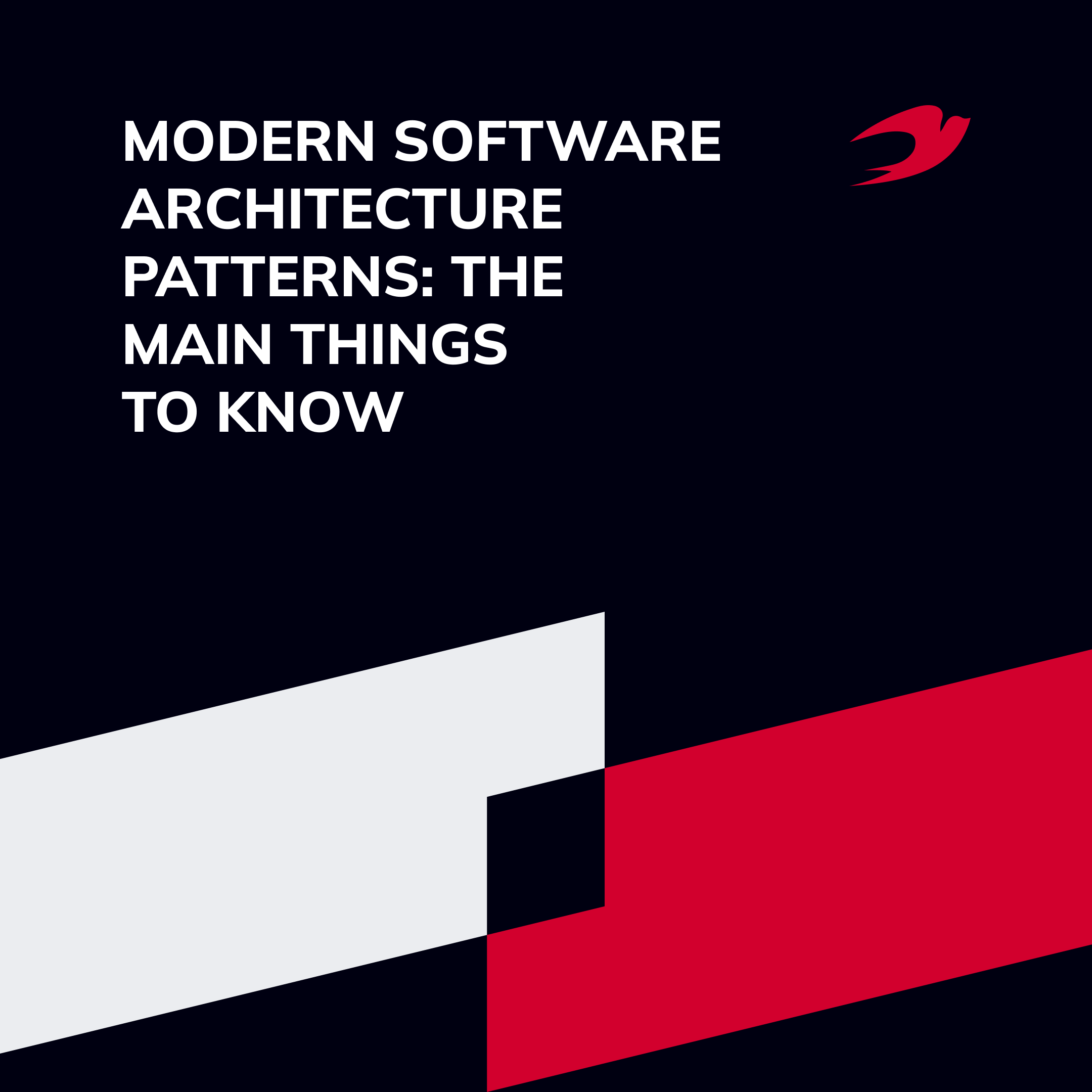Architecture patterns have become lifesavers in the software development industry. This is mainly due to their ability to improve software performance and scalability. And also meet the continually changing user needs and architecture trends.
But what makes them so valuable in terms of business app development? Which of these are actually a good fit for your business?
Discover a simple overview of the most popular architecture models and which one to choose for your project with IdeaSoft!
What Software Architecture Is & How It Works
Software architecture is one of the vital points in software development. It represents the design decisions related to the overall system structure and its components, as well as their relationship and the communication between them.
In other words, it is the foundation of any software system. It serves as the blueprint for software applications and acts as a development basis – for the developer team.
An architectural pattern is a universal solution to a commonly occurring problem within a given project. Basically, patterns act as templates applied for various architectural designs. Additionally, they are often applied in software documentation, helping stakeholders communicate and collaborate with each other.
The major goal of architectural patterns is to address different issues between the software components. And also ensuring their appropriate relationships and smoothing performance within a single environment.
Today, software architects utilize multiple patterns, which can significantly enhance project development. Thus, architectural patterns can benefit the development lifecycle, optimize project costs, improve user experiences, ease software maintenance, and so on. This helps add the finishing touches to your product.
Next, we’ll briefly review some of the most popular patterns applied by businesses, their significant benefits, and their usage in software app development.
What Are the Types of Software Architecture Patterns?
Knowing the specifics of each pattern can help understand their actual value and potential benefits in developing any project. Here’s a list of the most popular architectural patterns from IdeaSoft:
- Layered pattern
- Event-Driven pattern
- Microkernel pattern
- Peer-to-peer pattern
- Microservices pattern
- Space-Based pattern
- Master-slave pattern
- Pipe-filter pattern
Fear not: below, we’ve already explained the essentials of each architecture pattern and what advantages they can bring in terms of project development and business growth! On top, you can also try to optimize your mobile app or any other solution performance with integration of AI mechanism into it.
Layered Architecture Pattern
Layered architecture pattern (also known as the n-tier or multi-layered pattern) is one of software development’s most popular architecture frameworks. This pattern consists of a hierarchy of separate horizontal layers. Each of layers has distinct advantages but works together as a single unit of software. Typically, a traditional layered architecture in software engineering is classified into three tiers and four distinct layers:
- Presentation layer
- Application (Business logic) layer
- Data Access
- Database
The main goal of this pattern is to organize the app components by dividing them into small pieces so that each of them will contribute to a different part of the overall system. In some cases, you can find the grouped layers, in which the functions and responsibilities of the separate layers are implemented into a single, combined solution.
Advantages & Usage of Layered Architecture
The pattern is widely used for projects of different scales and industries, from startup development to large-scale software solutions. In particular, you can find layered architecture in eCommerce web front ends, enterprise software solutions, etc. Some of its major usage cases are:
- Applied for projects that require rapid development
- Fit for simple and small applications, as well as larger projects
- Used for enterprise apps with traditionally established IT departments and standardized workflows
- Implemented for projects with strict standards of maintainability and testability
- Works for inexperienced developers with little expertise in architecture patterns
Event-Driven Architecture (EDA) Pattern
This is a highly agile pattern. It is used for the creation and management of event-driven events initiated by the users of a software. The so-called “events” include the pressing of a button, adding an item to a shopping cart, or swiping a credit card. This architecture approach includes two major topologies:
- Mediator – used when multiple steps are needed to be orchestrated within an event bus through a central mediator
- Broker – used to link the events together (takes no resources from a major mediator)
One of the key benefits of EDA patterns for businesses is that they enable data collection, processing, and reporting in an efficient way. This gives business teams more time for critical tasks.
Advantages & Usage of Event-Driven Architecture
You can find event-driven patterns really helpful for apps with microservices, such as eCommerce stores or taxi services.
Overall, EDA patterns can come in handy in the following cases:
- Apps where individual data blocks interact with only a few modules
- Helpful for systems with an intuitive user interface
- For projects with limited space or time required by rows and columns of information in tables
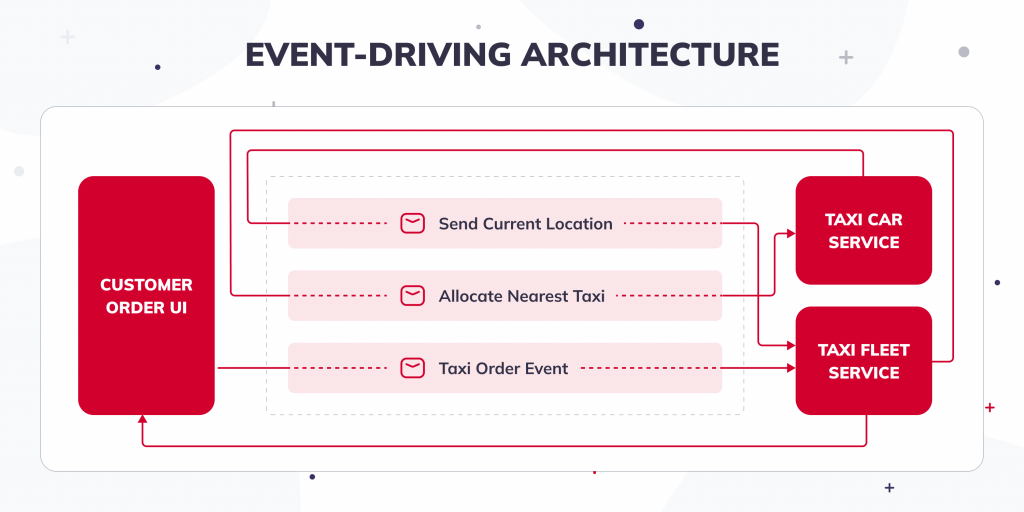
MicroKernel Architecture Pattern
The core components of the MicroKernel pattern include a generic kernel. The kernel can be embedded into nearly any existing operating system and plug-in modules. It allows easy customize the application and adds more to its functionality.
MicroKernel’s versatility and ease of implementation help developers rapidly add new features and modules to the software. Nevertheless, one of the most notable benefits of MicroKernel architecture in software engineering is that it enables plugging in the components right after their development or once the system is installed. This highly contrasts with the traditional software development model, where the module loading can be added only once.
Advantages & Usage of MicroKernel Architecture
In most cases, this pattern is used for applications that have a fixed set of basic routines and a dynamic set of high-order rules that need frequent updates. Therefore, the MicroKernel’s structure specifics make it an ultimate solution for the healthcare and banking industries, which require regular updates. Some other use cases of this pattern:
- If the product’s software system contains many integration points to external entities
- If the system requires frequent components updates (or plug-ins) and improved code control
- If the system must be able to adapt to changing system requirements
Peer-to-peer (P2P) Architecture Pattern
Peer-to-peer architectural patterns belong to the category of symmetric client-server patterns. Symmetric in this context means there is no need for a strict division in terms of client, server, and so on in the network of systems. A single system acts as a client and server in a peer-to-peer pattern. Each system, also called a peer, sends requests to other peers in the network. And at the same time, it receives and services requests from other peers, which are part of the network. This is a significant difference when compared to a traditional client-server network. There a client must only send a request and wait for the server to process.
This solution becomes extremely handy in blockchain-based app development, where a direct exchange of some assets between individual parties occurs without the involvement of a central authority. Our company possesses deep know-how of this tech solution, resulting in a vast number of successful projects based on P2P architecture. Therefore, IdeaSoft helped dozens of businesses across different niches to make the most of their P2P-based applications. Read about the implementation P2P pattern in Apps in another our article.
Advantages & Usage of P2P architecture
P2P networks have transformed file and data-sharing services, offering enhanced censorship resistance and efficient transactions. In contrast to client/server networks, where clients request information from centralized servers, P2P networks allow nodes to communicate directly with one another. This decentralized design results in several benefits, including improved network efficiency, resilience to failure, and privacy.
- Because of P2P networking capability, the other peers are still present even if one peer gets down. Thus nobody can take down the system.
- P2P networks offer greater security compared to traditional client-server systems.
- When you are using cloud computing to store your data, you need to trust AWS and Google drives, but with the peer-to-peer network, you don’t need to trust any third parties which can modify your crucial data. These are non-resistant to censorship by central authorities.
- These networks are virtually immune to Denial-of-Service (DoS) attacks.
- When paired with a majority consensus requirement, the distributed peer-to-peer network gives a relatively high degree of resistance to malicious activity.
Microservices Architecture Pattern
The Microservice pattern is also one of the most popular variations of software architecture. This pattern enables app creation from a set of loosely coupled, logic-driven services. Basically, it’s a decent alternative to monolithic applications and service-oriented architectures. It’s often adopted in modern web development & consulting projects where flexibility and scalability are key priorities.
Due to the extensive amount of components covered and its structural specifics, the pattern provides enhanced scalability and a high degree of decoupling within an application. This means the units can be separately developed, deployed, and tested without interdependency on any other component.
Advantages & Usage of Microservices Architecture
Though microservices architecture has a slightly different structure compared to MicroKernel, it also enables easy deployment or modification of new components. Therefore, it can work perfectly for both simple-design and more complex software products and fits exceptionally well for eCommerce projects. Some of the most common cases where microservices architecture patterns are used:
- In cases when the app requires rapid and frequent development and deployment
- If you want the developers to work independently on different app components without having to coordinate with other teams
- When you have a small team of developers and are looking for a convenient and productive development approach
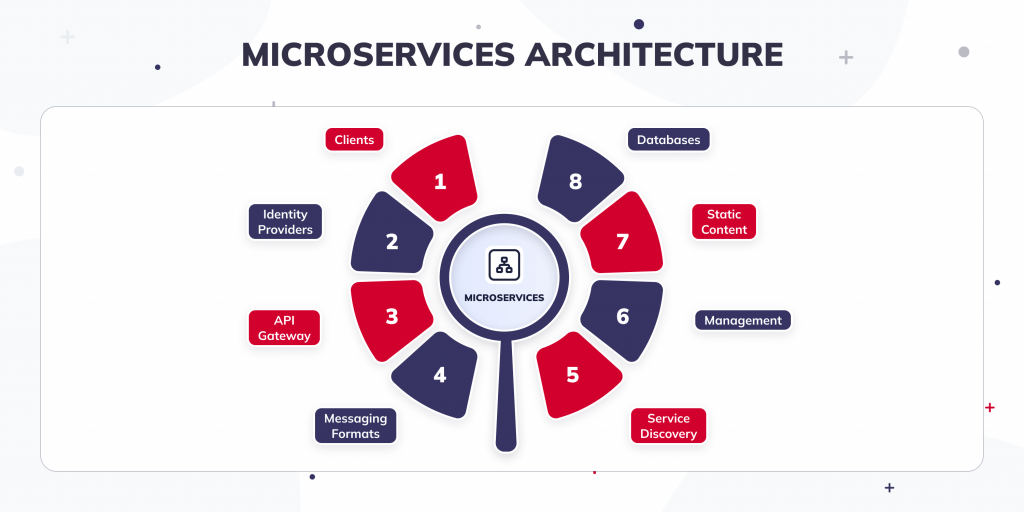
Space-Based Architecture Pattern
Space-based patterns are used to solve scalability and concurrency issues. As well as patterns are basically designed as a set of processing units that form the app’s basic architecture. In this model, the central database is replaced with the replicated in-memory data grids. It benefits the system parallelism and results in greater efficiency compared to the traditional CPU-based architecture.
Advantages & Usage of Space-Based Architecturе
Despite its comparatively expensive implementation, this architecture is still popular for smaller web-based applications with variable loads. Additionally, space-based architecture comes in handy for software with variable and unpredictable concurrent user volumes.
Overall, a space-based pattern can be really helpful in the following cases:
- For applications or software with a large user base
- When the system functionality has to be split to improve the software design and its general performance.
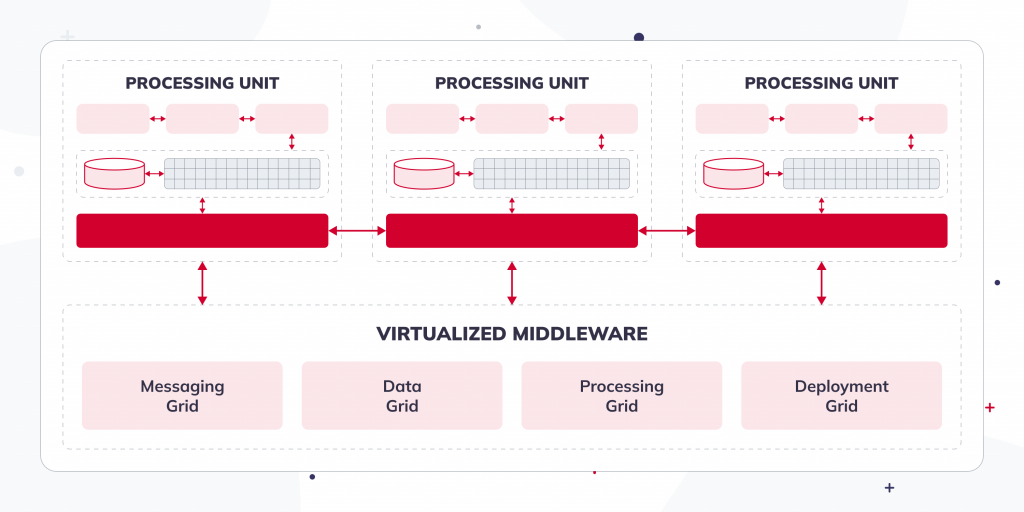
Master-Slave Architecture Pattern
As you might already guess from its name, this pattern also consists of two types of components:
- Master – responsible for managing the overall development process and controlling the activity of the slave-based processes
- Slaves – deals with specific tasks covering for instance, design flaws, structure, particular tools, system security and so on.
You can mostly find this pattern in distributed applications and concurrent programming. It allows you to segment the workload and perform different tasks in separate environments – “slaves”. In turn, the central role of the master component is to store the data, where all the writing operations of the data request are performed. At the same time, the read operations are distributed between slave components relative to it.
The first key benefit of such a model is the ability to distribute the load. The second key is to increase the performance of your software architecture.
Advantages & Usage of Master-Slave Architecture
In most cases, this pattern is applied to advanced applications with a complex structure, which require decomposition and distribution of the particular processes. One of the most prominent examples of the master-slave model is the database application, which deals with a variety of heavy multitasking processes. Here are some other usages for this architectural pattern:
- If the system involves similar or identical computations that need to be performed repeatedly with a separate set of inputs and contexts
- For the OS with a multi-processor compatible architecture
- To respond to user interface controls while collecting data
- For the apps processing raw data in different services over a distributed network
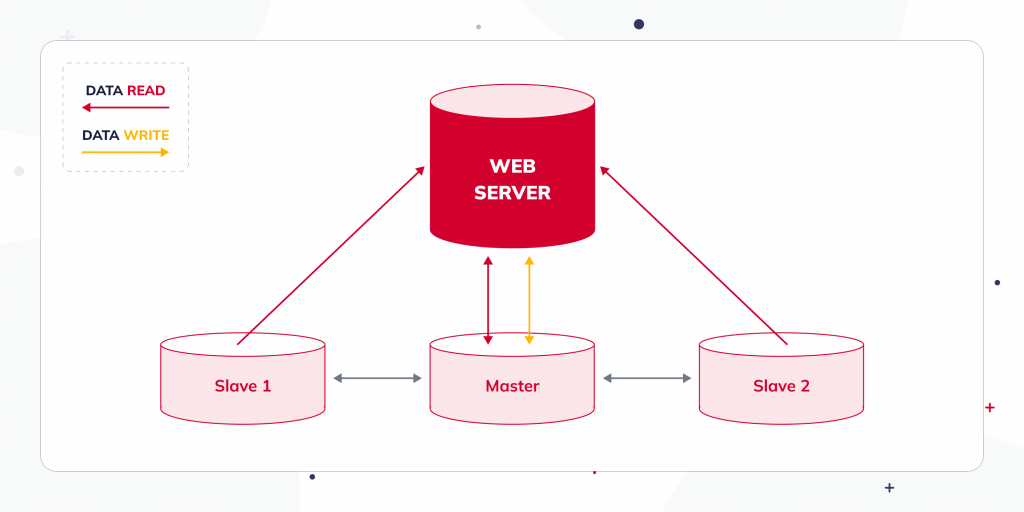
Pipe-filter Architecture Pattern
A component-based architectural style that enables users to split a monolithic processes into a sequence of processing steps. This pattern consists of three types of components:
- Pump – the initial source of data which is streamed or passed into the initial filter
- Filter – independent components responsible for a specific task within a system. It has no connection with the other filters or components.
- Sink (Consumer) – the target where the final output from a series or filters is collected
In the pipe-filter pattern. Data is processed through a sequence of filters, with each performing a particular task (like transformation, validation, conversion or others). Therefore, compared to other solutions, the pipe-filter architecture pattern can be easily used in parallel: each filter can run on a separate thread.
Advantages & Usage of Pipe-filter Architecture
Overall, the pipe-filter model can help maximize the performance of using several processors or cores. Additionally, the filters under this pattern can be independently modified, removed or added, with no impact for those that have already implemented into the system.
- For parallel processing and concurrent execution
- To decompose a task with complex processing into a series of separate, reusable elements
- For projects that require easy change of separate filters without affecting others
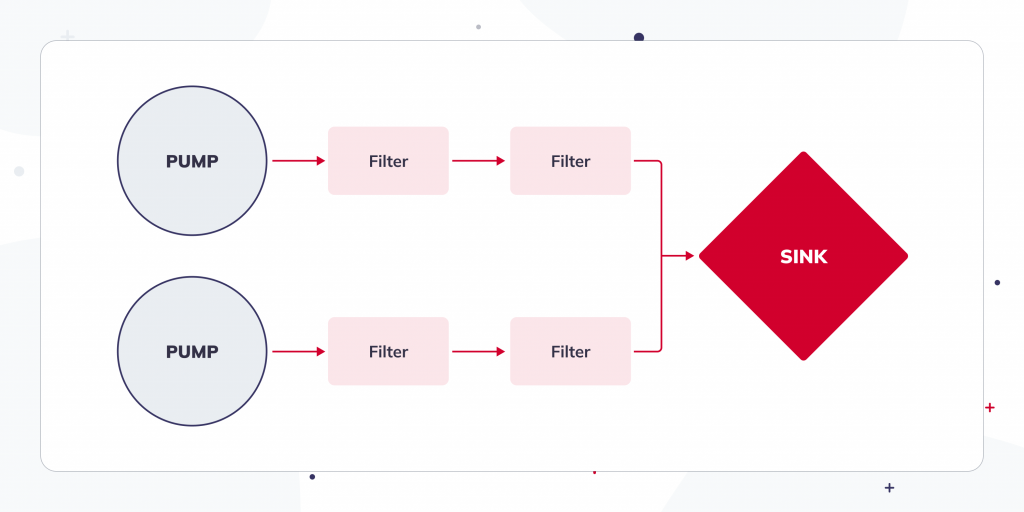
Summary
Ensuring the smooth performance of your software environment is of the essence, and for this purpose software architecture patterns can surely come in handy. When opting for the right pattern, you’re guaranteed to maximize the efficiency of your application with the most reasonable investments of time, resources and expertise.
We know how challenging it is to come up with the right development plan that ideally works for your business objectives and needs. That is why IdeaSoft is always here to help you develop the most efficient and effective software solution that ideally fits all your business needs. Our engineers are always in the loop of the latest development trends and architecture patterns utilized, so as to deliver the highest-class software product for your enterprise, regardless of its scope or industry specifics.
Contact us today and discover the proven solutions that will help your business grow right away!


